This is an archived article that was published on sltrib.com in 2017, and information in the article may be outdated. It is provided only for personal research purposes and may not be reprinted.
For Kyle Kuzma, it's the same old routine.
After the first-round NIT loss to Boise State last Tuesday, he took the rest of the week off for spring break. This week, he's back in the gym, training with strength coach Charles Stephenson and getting ready for the next step.
The biggest difference for Kuzmahttp://bit.ly/2lFn4I2";> is the next step could be the NBA.
The 21-year-old forward has declared for the NBA Draft this summer, but will not hire an agent yet — preserving the possibility that he could return for his senior year with the Utes. Under recent changes to NCAA guidelines, prospects can withdrawal as late as May, after the NBA Combine, to return to school.
While it's been long anticipated that Kuzma, a http://bit.ly/2mcxwUt";>6-foot-9 all-Pac-12 selection last season, could take this step, he said he wasn't ready to move forward until a recent conversation with coach Larry Krystkowiak.
"In short he really just said, 'It's a great thing if you come back, but if you get drafted, that wouldn't necessarily be a bad thing, too,'" Kuzma said. "All the coaches are happy that I'm having this opportunity to explore my opportunities. It's all positive vibes from everybody."
Each of the last two years, Utah has produced a first-round pick with Delon Wright (2015) and Jakob Poeltl (2016) both heading to Toronto. From the outset of the draft process, Kuzma appears to be less of a sure thing: In the Draft Express 2017 mock draft, http://www.draftexpress.com/profile/Kyle-Kuzma-82886/";>he's No. 51. He doesn't appear on ESPN's top 100 prospects list for the upcoming draft.
For Kuzma, draft success might be more about the intrigue of individual teams rather than a consensus view on how talented he is as a prospect. He hopes that with team workouts, he can show the versatility he did as a junior in college, leading the Utes with 16.4 points and 9.3 rebounds per game while adding 2.4 assists.
"Honestly I think the biggest misconception is that people should try to show their weaknesses and do what doesn't make them comfortable," Kuzma said. "I'm just going to try to do what I do — shoot, rebound, pass, defend. I think my versatility is the biggest thing I can bring, especially the way basketball is going with positionless players who can do a lot."
A native of Flint, Mich., Kuzma is excited to take a look at the NBA with fellow Michigan natives Miles Bridges from Michigan State and Monte Morris from Iowa State. Said Kuzma: "It's always good to have some of your friends who are on the same path."
As for coming back to school, what does that hold for Kuzma?
The Utes are looking at playing a bigger line-up next year, with Kuzma potentially playing more of the wing role that was envisioned this year. The plan was nixed with depth issues in the front court, but adding Donnie Tillman and a healthy Chris Seeley to a rotation that already includes David Collette, Tyler Rawson and Jayce Johnson should enable Kuzma to play more wing, which would be his likely NBA position.
There's also the matter of winning — Krystkowiak described a vision to Kuzma where a Utah team returning almost all of its talent could make a run at a Pac-12 title and possibly a deep run in the NCAA Tournament next season. Kuzma, as the star returner, could be in line for national recognition.
"The one thing we really talked about, honestly, was winning big," he said. "It's a great opportunity to go back to the tournament three out of four years."
There's a lot of time to think about it. He's expecting NBA feedback after the Final Four, and NBA Combine invites come out in late April. Until then, he's training as he always has, and working on his game.
Aside from the advice he's getting from the coaching staff, Kuzma's inner circle includes his mother, Karri Kuzma, and his prep school coach Vin Sparacio. But Kuzma said he's trying to make the best decision for himself.
"When you have people attached within your decisions, you can get biased or start to do things for other people," he said. "You've got to do what's best for you. That's just how I look at it."
kgoon@sltrib.com
Twitter: @kylegoon















